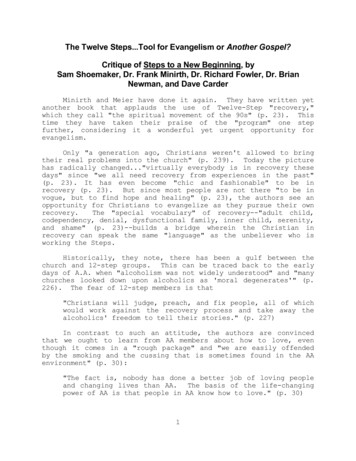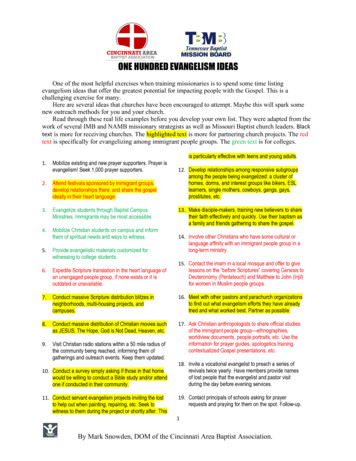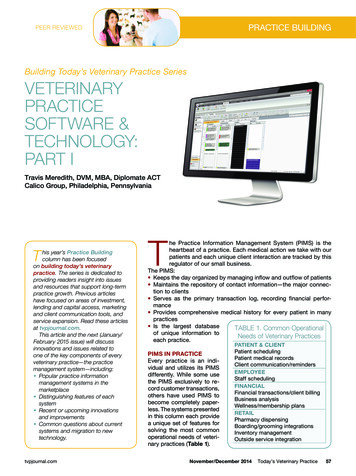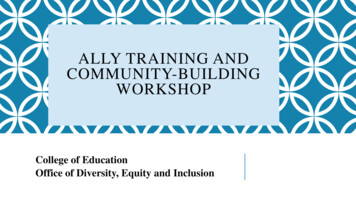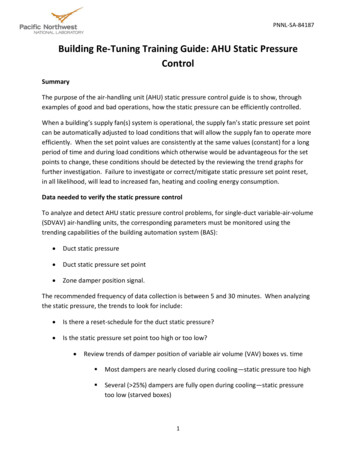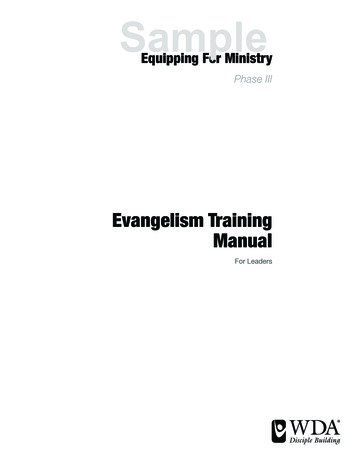
Transcription
SampleEquipping For MinistryPhase IIIEvangelism TrainingManualFor Leaders
Evangelism Training Manual, For LeadersEquipping For MinistryCopyright 2005-2017 by Worldwide Discipleship Association, Inc.All rights reserved. No part of these documents may be used or reproduced in any form or by anymeans without prior written permission of Worldwide Discipleship Association. These documents maynot be changed in any way or distributed for profit.For copyright information:Worldwide Discipleship Association(Attention: Margaret Garner)P.O. Box 142437Fayetteville, GA 30214 USAE-mail: mgarner@disciplebuilding.orgWeb Site: www.disciplebuilding.orgScripture quotations, unless otherwise indicated, are from THE HOLY BIBLE, NEW INTERNATIONALVERSION , NIV Copyright 1973, 1978, 1984, 2011 by Biblica, Inc. Used by permission. All rights reserved worldwide.The following Bible versions are also used:Scripture quotations marked NASB are taken from the New American Standard Bible ,Copyright 1960, 1962, 1963, 1968, 1971, 1972, 1973, 1075, 1977, 1995,by the Lockman Foundation. Used by permission.Scripture quotations marked RSV are taken from the Revised Standard Version of the Bible,copyright 1946, 1952, and 1971 the Division of Christian Education of the National Council of theChurches of Christ in the United States of America. Used by permission. All rights reserved.NOTE: In an effort to recognize that both men and women are co-heirs of God’s grace,we have chosen to use alternating gender pronouns in this document.However, we do recognize and embrace gender-specific roles in Scripture.Development Team:Bob DukesMargaret GarnerJack LarsonWriting Team:Bob DukesMargaret GarnerJack LarsonFrank MashburnMargo TheivagtPublishing Team:Nila DuffittBuddy EadesMargaret GarnerDavid ParfittEvangelism Training Manual L 1.31.2018Design by Cristina van de Hoeve doodlingdesigner.com
A Welcome from WDA’s PresidentWorldwide Discipleship Association, Inc.Hello Friend!Let me congratulate you on your decision to learn more about ministering toothers in the name of Jesus Christ. This decision is critical in your continuedgrowth as a disciple.Learning how to effectively communicate the gospel is an essential part ofgrowing as a Christian, but often, Christians are hesitant to share the gospelbecause of a lack of skill and knowledge, or because of fear of rejection. Thisresource will help you understand the gospel, prepare your testimony, answercommon questions people ask and communicate the gospel.My prayer and confident belief is that “he who began a good work in you willcarry it on to completion until the day of Christ Jesus” (Philippians 1:6) so thatHe is able “to present you before his glorious presence without fault and withgreat joy.” (Jude 1:24) To Him be glory and praise!May God richly bless you as you strive to grow in Him.Bob DukesPresident, Worldwide Discipleship AssociationFayetteville, GA 30214
SampleEvangelism Training ManualTable of Contents: Leaderbdk148How To Use This ManualPreparation For The Evangelism Field TrainingExperience: Instructions To The LeaderAssignment SheetSession #1Introduction To The Gospel(Teaching Outline)Session #2What Is The Gospel? (Pocket Principle )What Is The Gospel? (Teaching Outline)Session #311 Evangelism As A Process(Teaching Outline)Session #843 Time ManagementPart II (Guided Discussion)45 Apologetics:Dealing With Common Questions(Teaching Outline)47 Handout: Dealing With CommonQuestions People Ask55 Handout: Personal Objections PeopleHave To Becoming A ChristianSession #957 Apologetics: Dealing With CommonQuestions (Guided Discussion)Session #10-15Apologetics: More Than A Carpenter (Eachweek requires the disciple to read sections inthe book and come to the meeting ready toparticipate in a Guided Discussion.)Session #414 Levels Of Openness To Christ(Teaching Outline)2024262831Session #5How To Prepare And Give A Testimony(Teaching Outline)Handout: Chronological And ThematicTestimoniesHandout: Testimony Worksheets(Chronological & Thematic)Handout: Sample Testimonies (2)Handout: Language Barriers WorksheetSession #632 Testimonies (Guided Discussion)Session #733 Time ManagementPart I (Pocket Principle )38 Time ManagementPart I (Guided Discussion)41 Handout: Instructions For Making ASchedule586063666972Session #10Session #11Session #12Session #13Session #14Session #15Chapters #1-3Chapters #4-5Chapter #6Chapters #7-8Chapters #9-10Chapters #11-1375 Addendum A Types Of Evangelism FieldTraining Experiences81 Addendum B Evangelism Resources87 What’s Next?About WDA
SampleHow To Use This ManualThe goal of this manual is to train Christians to effectively communicatethe gospel. Ideally, these Christians should have a consistent, stable relationshipwith God, have a regular personal devotion time, faithfully attend a Bible study(or other small group), seek fellowship with Christians, and begin to showconcern for friends and relatives who are not Christians. (See WDA’s website:www.disciplebuilding.org for more information on progressive disciple building.Evangelism training is part of Phase III, Equipping For Ministry.)There are 15 sessions in this manual. We realize this is quite long. Pleaseremember that you know the needs of your disciples, and you should planaccordingly. We are making suggestions based on our experience. Some of thesessions are lecture-oriented while others are more interactive.There are homework assignments for some sessions, and it is very importantthat disciples complete the assignments. In each case, the following session isbased on the content of the assignment, and if the assignment is not completed, itwill negatively affect the session. The suggested assignment sheet is located justbefore Session #1.The Teaching Outlines are for you, the leader, to formulate a lecture, design adiscussion, or create another type of interactive session. For some subjects thereare also Pocket Principles , Handouts and Guided Discussions. Instructions toyou are in italics. Content for you to teach to the disciples is in regular type. It iscritically important that you read all leaders’ notes provided in this Manual.Each disciple will need to purchase the Evangelism Training Workbook. Theworkbook includes all of the Teaching Outlines, Pocket Principles , Handoutsand Guided Discussions along with all of Addendum B. However, the workbookdoes not include the Notes to the Leader, answers to the Guided Discussions orAddendum A. Also, note that documents in the Student Workbook will have thesame page number as corresponding documents in your Manual. You may needto explain to your disciples that they will have some missing page numbers andSessions, because those pages are only for you, the leader.Each disciple also needs to purchase More Than a Carpenter by JoshMcDowell. This book has had many printings and is considered a “classic” in thearea of basic, “user-friendly” apologetics. It will be used in the Apologetics sectionof this Manual, Sessions 10 to 15.b
SampleWhen learning evangelism skills, actually doing evangelism, not just hearingteaching about it, is very important. Thus, the role of the Life Coach (Leader) in thelife of a disciple is very important. You, the Life Coach, need to make sure that thedisciple has numerous opportunities to share his testimony and his faith so thiswill become a part of his lifestyle. Addendum A will help you decide what kind offield training experience is appropriate for your group.There are many effective gospel presentations. We have included a list of suggestedpresentations that we believe cover the important elements of the gospel. You willfind this list in Addendum B (Evangelism Resources). We want you to use thepresentation that you are most comfortable with. The choice is yours.c
SamplePreparation For The EvangelismField Training ExperienceInstructions To The LeaderThere is an oft-quoted maxim in the business community that says: “Those whocan, DO; and those who can’t, TEACH!” (The point, of course, is to emphasizethe importance of practical implementation.) But the very best doers are mostoften good teachers, and the very best teachers are also doers. Nowhere is thismore important than in the training for evangelism. For this reason, we mustinstruct in theology and methodology, but we must also include a practical fieldexperience as part of our evangelism training.It was Jesus Himself who said, “Follow Me, and I will make you fishers ofmen.” (New American Standard Bible) What occurs next in the gospel accountis a field experience conducted in the Galilean hills where Jesus trains Hisdisciples in effective evangelism methods by allowing them to work alongsideHim in ministry. They initially observed Christ conducting ministry, then theyparticipated in ministry alongside Him which led to them being supervised, andfinally they were sent out independent of Him. This four-fold training patternis central to Christ’s disciple building methodology. (See Disciple Building: LifeCoaching, WDA in our online store.) To be effective, our training in evangelismmust follow a similar, transferable pattern.Certainly a successful evangelism encounter can occur randomly andspontaneously. But the most effective forms of training in evangelism occurwhen there is planning and forethought. It is the responsibility of the leader todecide what is the best setting for the training, and then prepare accordingly.This will require good planning coupled with a confidence that God will gobefore us and sovereignly orchestrate opportunities for evangelism. A balanceof preparation and faith will insure a positive training experience. Let’s lookat some of the elements involved in preparing for an effective evangelism fieldexperience.I. HEART PREPARATIONThe writer of Proverbs reminds us that, first and foremost, we should keep watchover our hearts. Nowhere is this more important than in evangelism. Evangelisticheart preparation means focusing our attention on certain specific truths, amongthem: the power of the gospel to heal and restore the souls of people, the seriousstewardship entrusted to us, the availability of God’s power and presence, thereality of spiritual warfare, etc. (to mention a few).d
SampleHeart preparation also involves mental self-control. For most Christians there isa certain queasiness associated with sharing Christ with others. These feelingsare normal and can be strong in spite of our understanding of the power andvalue of the gospel. We may be fully convinced of the importance and relevanceof evangelism and be skilled in effective evangelism methods, yet still experiencedoubts and misgivings about sharing our faith with others. These fears arecommon and must be recognized and addressed before we proceed.Some of these concerns are linked to a fear of rejection by others. Often weunderestimate the power and subtlety of our enemy who desires to hinder theexpansion of the Kingdom through the proclamation of the gospel. We succumbto the lingering seduction of needing to be thought well of by others in order tofeel important. Regardless of the source, we must be on guard against fear andhave our hearts and minds prepared. Here are some reminders about fear thatmay be helpful to you and others:1. Be prepared to admit your fear. It serves no purpose to pretend you are notafraid. But you can also demonstrate confidence in your training and in thepromise that God will go before you.2. Ask God to break any residual thoughts that might hold you captive tofearing what others think of you. Renounce these thoughts as not originatingfrom Christ but from the world.3. Thank God for the privilege to represent His Kingdom as ambassadors andeven for the privilege of potential rejection and persecution that could result.4. Ask God for sensitivity and wisdom to know how best to approach peopleand what to say.5. Ask God for strength and courage to proceed.6. Gather together and agree to “bind the strongman” in the community. Jesusunderstood that we wrestle with principalities and powers that are morepowerful than our human resources. It is not wrong to admit and confessour inadequacy.7. Jesus declared that He had been given ALL authority in heaven and also onearth. But the authority was for the purpose of accompanying our efforts tomake and build disciples. We should expect His authority to be available. Infact, one sure way to understand Him better as King and Christ is by sharinge
Sampleour faith with others (Philemon 6).8. Memorize and meditate on specific Scripture passages that encourage faithand obedience and the rewards of faithfully managing the good news thathas been entrusted to our keeping.9. Find a partner for both encouragement and accountability.10. Practice communicating your presentation with someone who you alreadyknow. Share with her that you are just learning how to verbalize your faithand that you are nervous. Ask if she would let you “practice” and then giveyou feedback. (There are many friends and family members who have cometo Christ this way. Some of these have been church members.)11. Don’t wait until you feel courageous. Often the feelings of courage don’tdevelop until we have made a commitment to proceed. Even then it may notbe until afterward that we experience the exhilaration of obedience.12. Remember that it is NOT our responsibility to persuade or convert anyone.That is the job of the Holy Spirit. It is our job to be a caring messenger of thegospel.II. LEARNING FROM JESUSJesus taught His men how to evangelize in a multi-tiered fashion. He startedthem with fairly easy contacts, and increasingly put them in more difficultarenas. Each new arena required a different approach. Jesus was ultimatelypreparing them to go to the whole world. Note that the Great Commission wasnot given to His men until they had completed all the training He gave them.After Jesus called His men to be fishers of men (Phase III–Ministry Training), Hetook them on a series of evangelistic tours. On these tours He developed a morepublic preaching and evangelistic ministry. Until this time, His ministry had beenmore private and behind the scenes, and most of His evangelism had been oneto-one (John 3 and 4). As His ministry became more public, He drew interestedcrowds by healing and casting demons out of people. The crowds came to seewhat was happening and to get help.As Jesus did more public speaking, the crowds grew, and not everyone was ableto get personal attention from Him. This gave His men natural opportunitiesto explain to people, who could not get to Jesus, who He was. Jesus’ preachingcreated one of the most natural venues for His men to do evangelism with aninterested crowd.f
SampleAfter choosing The Twelve (Phase IV–Developing New Leaders), Jesus involvedthem in a different, more difficult kind of evangelism (towards the end of PhaseIV-A): He sent them out two by two to cities in Israel. They went to people likethemselves, but who were not necessarily interested in knowing about Jesus. Heinstructed them to go from house to house until they found someone who wouldreceive them and their message. They were to stay in that house, setting up abase of operations from which they could network with others.Later Jesus took them into Gentile regions and involved them in cross-culturalevangelism (Phase IV-B), another new challenge. He again drew an interestedcrowd by feeding the 4000, giving them natural opportunities to share thegospel. In this case, there were common languages (Greek and Aramaic) thateveryone spoke.Before leaving this world and giving them the Holy Spirit, Jesus demonstratedhow to handle an angry crowd when doing public evangelism (Phase V–Developing Mature Leaders). He modeled several principles including when toleave. Jesus placed His men in all these situations because they were going toneed to know how to handle these situations when they were sent out to makedisciples of all nations.III. LOGISTICAL PREPARATIONI (Bob) asked a friend of mine (who is in much better physical condition than Iam) to share with me the best form of cardiovascular exercise. His answer wassimple: “Any exercise that you will actually DO, is best!” The same is true ofevangelism. There are many different types and approaches to sharing Christ.Countless books and training manuals have been produced that offer valuabletools and training methods. If your ministry or denomination has alreadyestablished some training approaches, it would be wise to consider using oradapting these for your group. Remember, the best approach is the one that youwill actually do.It is imperative that you as a leader be realistic and practical as you plan. Itwould be better to implement an event that is simple, but attainable, than toplan a more elaborate project that may require too much of your trainees orinfrastructure. A successful field experience is one that contains the followingcomponents:1. The trainee has an opportunity to meaningfully encounter people who maynot be Christians.g
Sample2. The listener has an opportunity to hear about Christ.3. The trainee prays for the listener (either in person during the encounter orprivately after the encounter occurs).4. There is appropriate follow-up to the event.There are many different types of field training experiences. The leader shouldseek the specific guidance of the Holy Spirit and be creative and sensitive inhow to best approach their non-Christian community. (Remember, your goalin presenting the gospel is not just to communicate information, your goalis to communicate a credible witness.) It is important to be authentic peoplewho really care about others. This underlying worldview and value system isa strategic part of the training that you transmit to your disciples. Any fieldexperience we plan should take this into account.In Addendum A of this Manual you will find a discussion of different types ofevangelism training experiences. It is critically important that you put thoughtand prayer into choosing an experience early in this training process.IV. A TEAM APPROACHRegardless of the type of field training experience you choose, it is best if theentire Ministry Team can be involved in the planning process. There are severalreasons for this. Initially it provides team ownership of any method, thusinsuring better buy-in and deployment. Mutual brainstorming also employs thecreativity of the group versus the creativity of one individual. This “group-think”can insure a better outcome. Team planning also begins to lay the foundation forongoing team ministry. This dynamic will grow and develop even more in thenext phase of disciple building.It is the job of the leader to keep the group focused on the goals and specificoutcomes. The group may be willing to settle for something less than theresults needed to insure effective training, but the leader must demonstrate awillingness to flex with the specifics without abandoning the non-negotiables.This will require wisdom and the Spirit’s anointing.V. A MINISTRY-WIDE FOCUS ON EVANGELISMTo be most effective, the evangelism field experience should be part of a ministrywide coordinated effort. For this to occur, the ministry leadership must plan aseries of evangelistic outreach projects that work in concert with the Phase IIIMinistry Training. Then, training in evangelism becomes more than a single event.h
SampleIt is a sustained focus with many different approaches blended together. In thisway, momentum is maintained and more options for training are made available.In addition, this evangelistic focus helps to produce an entire new generationof disciples. These disciples will need help in their spiritual growth anddevelopment. As the Phase III ministry trainees mature, they become thenext group of new leaders. This pattern of outreach, followed by subsequentassimilation and development, is optimum for healthy growth in the church.Repeated generational development occurring in the context of equippingexisting
, WDA in our online store.) To be eective, our training in evangelism must follow a similar, transferable pattern. Certainly a successful evangelism encounter can occur randomly and spontaneously. But the most eective forms of training in evangelism occur when there is planning a

